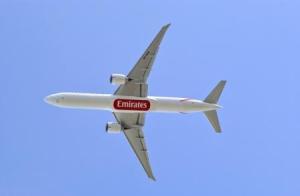Emirates has placed the single largest aircraft order in dollar value in Boeing’s history for an additional 50 777-300ER aircraft, worth approximately USD$ 18 billion in list price.

Emirates has ordered another 50 Boeing 777-300ERs
The order also included 20 777-300 ER options valued at USD$8 billion, for a total of 70 aircraft valued at USD$26 billion.
This record breaking long-range aircraft order adds to Emirates’ existing world’s largest fleet of 95 777s in service, including nine 200ERs, ten 200LRs, twelve 300s, sixty one 300ERs and three freighters.
Emirates had 40 777-300 ERs already on the order books, so with the latest order that now stands at a firm order of 90 777-300ERs.
“With 61 777 300-ERs currently in service, this record breaking dollar value order is another milestone for Emirates and affirms our strategy to expand our long haul destinations and continue to excel as a world leading carrier, connecting the world to Dubai and beyond,” said H.H. Sheikh Ahmed Bin Saeed Al-Maktoum, Chairman and Chief Executive, Emirates Airline and Group.
“The Boeing 777-300 ER aircraft plays a pivotal role in Emirates development of a modern fleet to meet the demand for global air travel for the future.”
The 777-300ER will be operated in a three-class configuration with eight First Class suites, 42 Business Class seats and 310 Economy Class seats and offers an additional cargo payload of 20.1 tonnes.
“The 777-300ER order gives Emirates the ability to replace some of our older existing aircraft, allowing us to maintain our leadership in fuel efficiency as well as providing our customers with an updated superior product,” said Tim Clark, President, Emirates. “Our passengers can look forward to continued innovations in aircraft comfort, entertainment and service for which Emirates is renowned.”
The airline is on track to become one of the largest airlines in the world. In addition to the 50 777-300 ERs announced this week, Emirates has 73 Airbus A380s, 70 Airbus A350s, 40 777-300 ERs and six Boeing freighters on order, for a total of 239 wide-body aircraft worth more than US$92 billion.
